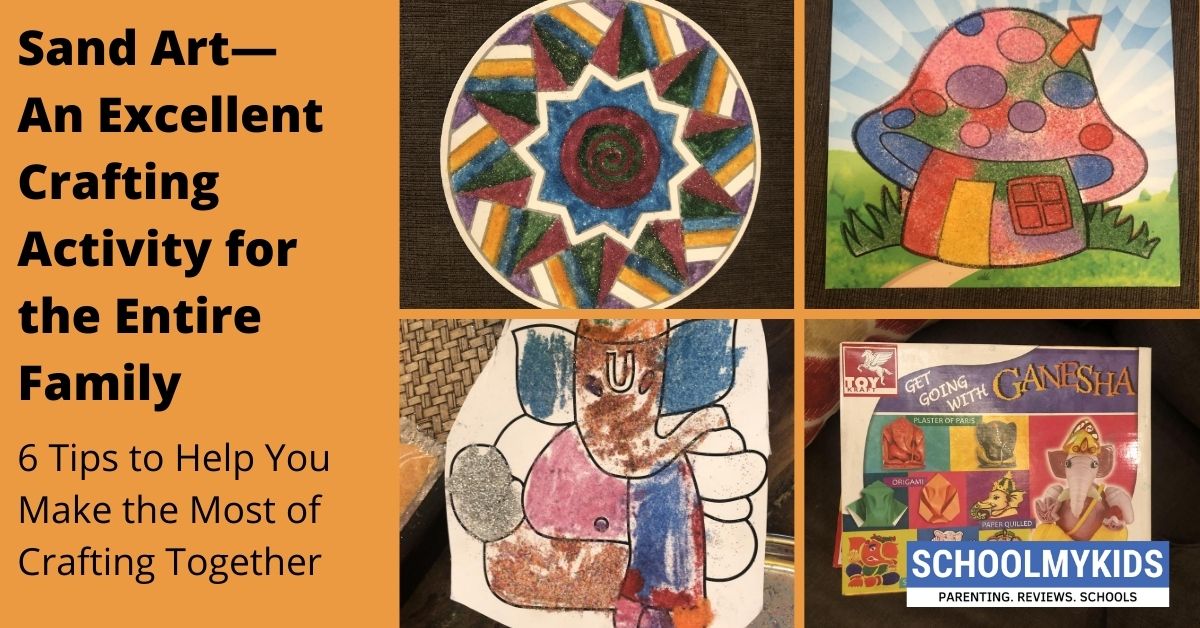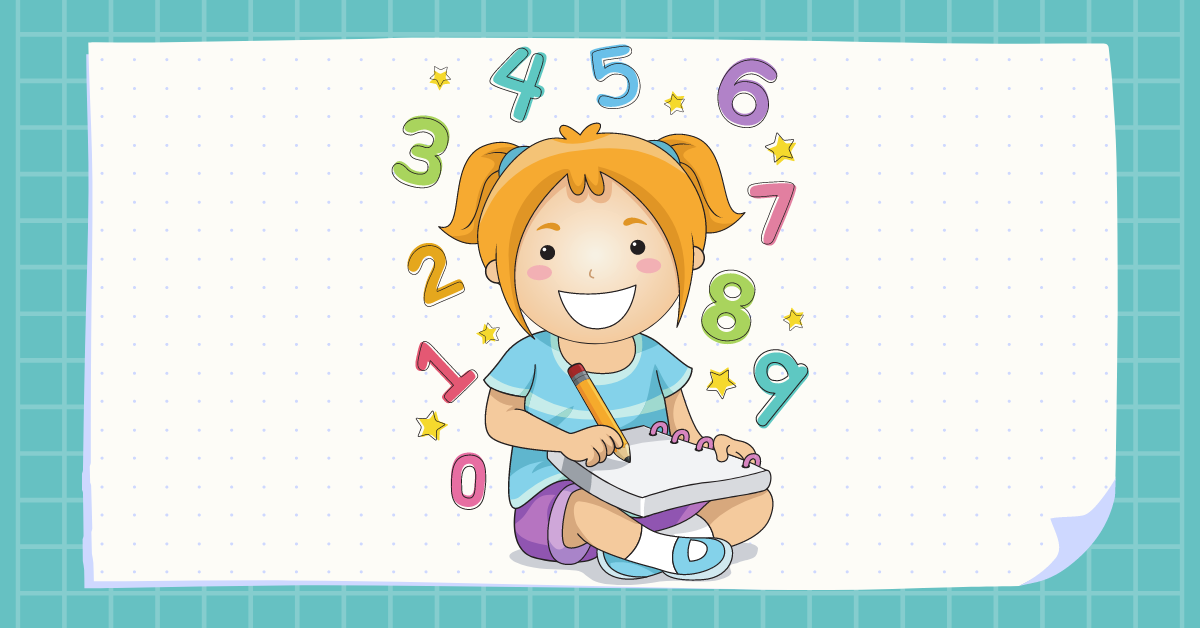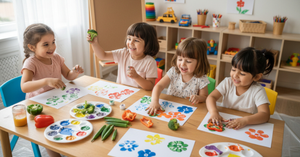My wife and I are always looking for activities we can do together as a family.
A few of our favorite activities at the moment include playing UNO, riding our bikes in our neighborhood, while wearing masks and helmets, of course, and setting up scavenger hunts in the house. For scavenger hunt ideas, check out two of my past blogs Best Scavenger Hunt Ideas for Kids and 7 Tips to Help You Plan a Scavenger Hunt for Kids.
A few days ago, we got around to using a sand art kit I bought months ago. We had a lot of fun completing our sand paintings and found the whole experience a great way to bring our family together. Set-up and clean-up are easy. Everyone has a cool piece of art in the end, no matter how talented, or untalented, you believe yourself to be. It’s the perfect pandemic activity for any age that combines creativity and concentration.
Go to Amazon or Google “sand art kits.” You will find many options and themes sure to fit your and your child’s interest.
It is always helpful for us parents to have a few go-to activities that are easy to organize, fun for everyone, and if possible, helps our kids develop fine motor skills and cognitive skills, such as creativity and concentration. Below are a few tips, ideas, and personal examples you can use to make the most of your sand-art-activity time together.
6 Tips to Help You Make the Most of Sand Art Crafting Together
Tip #1 Introduce the Kids to Sand Art
Before starting your own project, introduce your child to various kinds of sand art. Here are a few examples:
- Rangolis
Rangoli is a form of sand art from India. The art is created on the floor with colored materials including sand, rice, and even flower petals. Rangolis are usually created during Diwali and other Hindu festivals. Design are traditionally geometrical, of deities, and flowers. Rangolis represent strength and generosity and are also made to celebrate marriages, festivals, and other auspicious events.
- Sand Art and Play
Sand art and play are usually associated with sculpting images or building sandcastles generally on the beach near the ocean.
- Sand Drawing
Sand drawing is the practice of drawing in the sand. Sand drawing is recognized as an art form for artists like Pablo Picasso, who used it as a way to plan his paintings. The Ni-Vanuatu people, from the central and northern islands of Vanuatu, used sand drawing to create images representing mnemonic devices to orally pass down rituals, mythology, and history from generation to generation.
- Sand Mandalas
Sand mandalas are part of the Tibetan Buddhist tradition and come in various designs, many of them geometric or representing a deity. These designs are painstakingly created by the monks with colored sand on the ground and are later swept away to represent the principle of impermanence: nothing lasts forever.
- Sand Painting
Sand painting is the practice of pouring colored sand to make an image or painting. Sand paint is more aligned with what you will find in the kits we are using. Sand painting is often done on a surface, in our case, a card with an image or template that we will color with various colors of sand. The colored sand can be poured, moved with a utensil like a spoon, or in our case, gently tapped out of the plastic pouches that hold the sand. Sand painting has its own historic roots practiced by Native Americans in the United States, Tibetan and Buddhist Monks, and the indigenous people of Australia.
Tip #2 Explore Your Sand Art Craft Kit Options
Go to Amazon, your favorite art store online, or in-person (wear your mask!), and check out the selection of sand art kits. On Amazon, I’ve found sand craft kits with jungle, dinosaur, mermaid, Madhubani, Disney, and mandala themes, to name a few.
These kits are quite reasonable, 250 INR and up (around $3.50 USD), so I like to buy a few different kits at a time so we have some choice when choosing a theme at home. This way, you’re sure to have a kit or two that fits everyone’s interest.
On this day, we chose a Ganesh themed sand craft kit in the sand painting tradition described above, and each of us decided on a Ganesh card template that spoke to us.
Tip #3 Let Your Child Pick the Theme
When we provide our kids choices, we side-step potential disagreements while supporting their development. Check out my past blog, Giving Kids Choices—Providing Choices to Our Kids During Summer Break, “When we provide kids with choices and support their decisions, we help them develop the skills to think on their own, resist peer pressure, and be resilient when faced with a challenge.”
When planning an activity, I like to create opportunities for my daughter to exercise choice in what we do and how we do it. You can apply this tactic to most any activity. In this case, let your child pick the sand painting activity theme they want to do. In the Ganesh sand painting project we completed, our daughter chose the card template, the colors she used, and aesthetic decisions like staying within the lines and mixing colors. “One of our basic human drives, and a vital element to a human being’s development, is to feel powerful and in control.”
One of the challenges I recognize in myself and many of the problems I witness with other parents, is trying to unnecessarily control our children. Once I learned that offering our daughter choices is not only developmentally appropriate, and one of her natural drives, I let go of controlling every detail. For example, let’s say my daughter didn’t want to do a sand painting. Instead of arguing, why not shift gears, and offer her a choice. As parents, we control the choices. So, we can simply start with accepting their decision that sand painting is out. HOWEVER, instead, they MUST choose one of the following activities: finger-painting, origami, or weaving. Examine the hang-ups with your child and simply ask yourself, can I offer a few acceptable choices from my end and let them choose? If the answer is yes, try it out, the more you consciously provide options, the more natural the process becomes.
Tip #4 Set Up and Clean Up of Your Sand Art Activity
Setting up and cleaning up for a sand art project is easier than you might think if you follow these tips:
- First, most kits will include
the following:
- Card templates based on the theme of the art kit. Our package included 4 different Ganesh card templates.
- 8 packets of colored sand.
- 1 bottle of glue. Have ready your own child-friendly, water-based glue. We definitely needed more than the kit included.
- 1 brush for spreading the glue.
- Second, before setting up, put
down some type of fabric or material to catch the sand that doesn’t adhere to
the card. This is important because after you pour sand on the area of the card
you are working on, you will tap the card to remove the loose, excess sand.
Here are a few examples:
- Do the activity outside or any area of your home where it’s easy to sweep up the sand.
- Place a drop cloth over the area you will be working.
- On the table, place a large sheet of paper or newspaper to under the template to catch the sand.
- Or, what we like to do, give each person a large plate you’re ok with getting sand and glue on.
- Third, the brush is used to help you spread glue over an area that you want to paint with the sand. Our kit only came with one brush. It’s a massive help if you have a couple of other old brushes, so everyone has a brush. Soap and hot water even days after will get most any water-based glue out of the brush.
- After everyone is finished, designate a place for the sand paintings to dry, where you can easily catch and clean up any loose sand.
- Everyone should be dressed in clothes that you’re willing to get colored sand and glue on.
With these tips, clean up should be a cinch. Shake out excess sand outside or in the bin and repack the left-over materials in the box.
Tip #5 Be Ready to Put Your Sand Painting Down
I have trouble with this one from time to time. I love art and being creative. I am the dad that becomes so wrapped up in his own sand painting, he forgets anyone else is there. Try not to do that.
While I do think it’s essential for our kids to see us follow our passion, at the same time, our primary goal here is to support our child’s creativity, answer questions, offer positive and age-appropriate feedback, and stay out of the way until needed. So, put your sand painting down if your kids want your advice about color, staying in the lines, or sand art painting. In our case, reminiscing about the Ganesh statues we saw at Durga Puja last year. Enjoy the moment, and if your work is interrupted, finish it another time.
Tip #6 Document and Display Your Sand Art Activity
While I don’t do this for every activity, I like to document our progress when we get together as a family for a project like this. Taking photos of the materials, the blank slate, the first steps, halfway through, and the finished project are just fun and educational to see. Following directions and understanding how each step contributed to the overall effect of viewing the finished project is an important skill and helps us not feel overwhelmed when working on a project.
Suppose you are on social media and like to share pictures of the family. In that case, a series of photos showing everyone’s progress is fun. If you don’t use social media for activities like this, sharing a few pictures on email to the grandparents, other family members, or friends is always appreciative. Or keeping them just for yourself and your family’s own viewing, having a series of photos that document everyone creating a project together, in my opinion, makes a fond memory. The photos are easier to store for the long term than the sand art pieces themselves, which you will eventually want to dispose.
Benefits of Craft Time with the Family
Whether it is sand art, finger painting, or sculpting Play Dough, crafting together produces a variety of benefits for our kids. Learning a new skill, developing motor skills, self-expression, critical thinking, and socializing are just a few of the benefits your child, and let’s be honest, we can benefit, too, from crafting together. I hope these tips, ideas, and personal examples to help you see the benefits and added value you can bring to most any family crafting opportunity.
If you have any experience, wisdom, or ideas on crafting together as a family, please share in the comments below.








Be the first one to comment on this story.